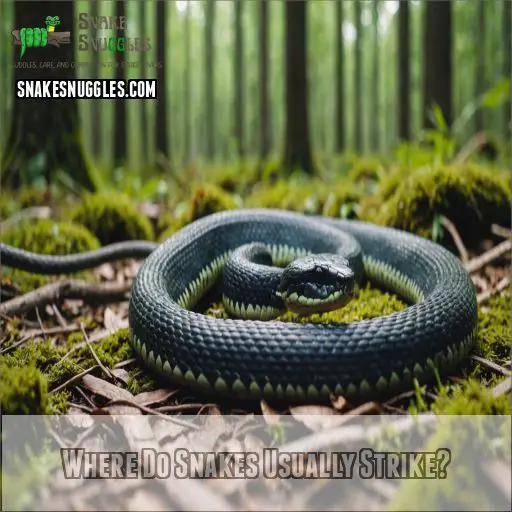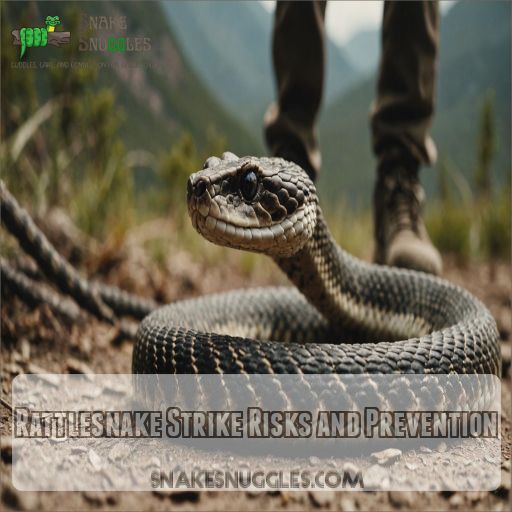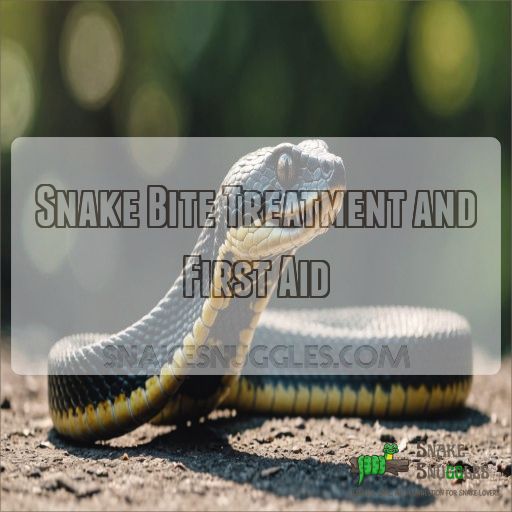This site is supported by our readers. We may earn a commission, at no cost to you, if you purchase through links.

Well, snakes can strike up to half their body length, though rattlesnakes might surprise you by extending nearly their entire length. It’s a bit like playing a high-stakes game of fetch; you don’t want to get too close!
A good rule of thumb is to keep a safe distance—think at least 10 steps back. After all, maintaining that buffer guarantees you won’t come into striking distance unexpectedly.
Curious about how snakes strike even without coiling? Stay tuned for more on how snakes strike and the importance of maintaining a safe distance.
Table Of Contents
- Key Takeaways
- Snake Strike Distance
- Can Snakes Strike Without Coiling?
- Where Do Snakes Usually Strike?
- Rattlesnake Strike Risks and Prevention
- Snake Bite Treatment and First Aid
- Frequently Asked Questions (FAQs)
- What is the range of a snake strike?
- How far can snakes strike?
- Can a snake strike if not coiled?
- Where do snakes usually strike?
- Do snakes strike more during specific seasons?
- How fast can different snakes strike?
- Are certain snake species more accurate in striking?
- Can weather conditions affect snake strike behavior?
- What signs indicate a snake is preparing to strike?
- Conclusion
Key Takeaways
- Snakes can strike up to half their body length, but rattlesnakes might surprise you by reaching nearly their entire length. Think of them as sprinters at the Olympics – you don’t want to get caught in their personal race lane.
- Always stay at least 10 steps back when you spot a snake. Consider it your safety zone, like giving a celebrity their space on the red carpet, ensuring they don’t feel the need to perform a surprise act.
- Remember that rattlesnakes don’t always coil before striking. It’s a bit like getting a punch without the boxer winding up first. Stay alert for their quick, stealthy moves – no telegraphing their next move here.
- Snakes prefer striking targets close to the ground, often the legs or ankles. It’s their version of targeting the low-hanging fruit, so keep your wits about you and avoid being the ripe peach in their picnic plan.
Snake Strike Distance
Ever wondered how far a snake can strike? Brace yourself, because it might just cover a surprising distance—one that’s equal to or longer than its own body length!
How Far Can Snakes Strike?
Ever wondered how far a snake can strike?
Most snakes, including venomous rattlesnakes, can strike up to half their body length.
This depends on snake behavior and strike accuracy, making it really important to maintain a safe distance to learn more about their defensive behaviors.
Stay alert!
Factors Affecting Strike Distance
Understanding how far away a snake can strike involves snake size, prey size, and terrain.
A snake’s body condition and age also play roles.
Handling techniques, snake identification, and human safety awareness contribute to reducing strike risks during snake removal.
Snake Species and Strike Distance
Considering different snake species, size and speed play critical roles in strike distance.
Larger snakes, like rattlesnakes, can strike nearly their body length.
Their behavior, influenced by habitat and warning signs, underscores why knowing rattlesnake rules is essential for safety.
Human Safety and Strike Distance
To stay safe, keep your distance – rattlesnakes can strike up to half their body length!
Avoid sudden movements, and give them a wide berth.
With a little caution, you can enjoy the outdoors worry-free.
Can Snakes Strike Without Coiling?
Think snakes always need to wind up before striking? Surprise! Sometimes they can strike even when uncoiled, a bit like throwing a punch without warning—talk about sneaky!
Strike Patterns of Rattlesnakes
Here’s the scoop on rattlesnake strikes: they can launch themselves at alarming speeds, showcasing impressive strike accuracy and power.
While they often coil first, these sneaky serpents don’t always play by the rules.
A rattlesnake could surprise you by striking without warning—talk about living on the edge!
Importance of Coiling in Snake Strikes
Coiling mechanics play a critical role in a rattlesnake’s ability to strike with precision.
Like a tightly wound spring, coiling helps the snake strike accurately and effectively deliver venom.
Proper body positioning creates a defensive posture, maximizing speed and reach—as if the snake’s mastered the art of the perfect martial arts move.
Coiling mechanics also enable the snake to strike with precision.
Non-Coiled Strikes and Their Implications
While coiling improves strike power, some snakes strike uncoiled too.
Here’s a bite-sized list on uncoiled strike dynamics:
- Reduced warning: Less chance to back away.
- Unpredictable patterns: Keep guessing!
- Increased accuracy: Bullseye!
- Venom delivery efficiency: Striking without coiling can still pack a punch.
Stay safe!
Where Do Snakes Usually Strike?
You’ll likely encounter a snake strike on your legs or feet, especially if you’re not paying attention while enjoying a hike through snake territory.
Snakes have specific strike zones, so knowing where you’re most vulnerable can help you avoid an unwanted surprise.
Common Strike Locations on Humans
Rattlesnakes often strike at the lower extremities, where they’re most likely to encounter a threat. The legs, ankles, and feet are prime targets, as they’re closest to the ground. But don’t let your guard down – snakes can also strike the hands, arms, and even the torso if provoked.
| Strike Location | Likelihood |
|---|---|
| Legs/Ankles | High |
| Hands/Arms | Moderate |
| Torso | Low |
Be vigilant and keep a safe distance, as rattlesnakes can strike swiftly and without warning. Staying alert and knowing where they typically aim can help you avoid a painful and potentially dangerous encounter.
Snake Strike Zones and Their Characteristics
Imagine this: you’re minding your own business when, snap! A snake identifies its target zone, often ankles and lower legs, due to proximity.
It’s all about anatomy and defensive strikes.
Snakes have acute perception zones, ensuring they don’t miss, as they assess their predictive strike factors cautiously.
Factors Influencing Snake Strike Locations
Feeling like a detective on a mystery case, you’ll find that snake strike locations hinge on environmental conditions and prey availability.
Human activity can unknowingly provoke; temperature variations and seasonal changes also play roles.
Understanding these factors helps avoid risky encounters, ensuring your outdoor adventures remain enjoyable and safe by familiarizing yourself with common snake species.
Rattlesnake Strike Risks and Prevention
Understanding rattlesnake behavior can greatly reduce your risk of startling one and getting struck.
Watch where you step, avoid rocky areas they love, and always use a flashlight when it’s dark—nobody wants a surprise meeting with the original maracas on the trail!
How to Avoid Rattlesnake Strikes
To dodge a rattlesnake’s bite, always tread carefully through their habitat.
Stick to established paths and keep an eye peeled for any slithering surprises.
Wearing boots—think of them as your knightly armor—helps, too.
Remember, snakes are shy creatures; give them space, and you’ll remain unscathed.
Rattlesnake Behavior and Warning Signs
You’ve mastered avoiding rattlesnake strikes, so now know their behavior for extra safety.
They often rely on mimicry and camouflage.
Rattlesnakes aren’t aggressive by nature, preferring to escape rather than strike.
Safety Precautions for Rattlesnake Encounters
When hiking, stick to paths, avoid tall grass, and wear high boots to avoid risky encounters.
Hiking safety and child safety are important during adventures.
If you see a rattlesnake, back away slowly – they aren’t looking for a wrestling match!
Teach kids to freeze if they’re near one.
Snake Bite Treatment and First Aid
When a snake bite happens, staying calm and knowing the right steps can make all the difference—you don’t want to be the one who faints from panic, especially if you need to administer first aid!
Quick action and a clear head are your best allies, so let’s explore the dos and don’ts of snake bite first aid to make sure you handle the situation like a pro.
Immediate Response to Snake Bites
Remain calm if bitten by a snake – don’t panic!
Immobilize the affected limb and keep it below heart level to slow venom spread.
Transport the victim to the nearest medical facility immediately.
Don’t attempt to capture or kill the snake – focus on getting prompt, professional care.
- Remain calm
- Immobilize the affected limb
- Keep the limb below heart level
- Transport the victim to medical care
Medical Treatment for Snake Bites
In the wild world of snakebites, getting treatment quickly is key.
Hospital protocols focus on antivenin effectiveness to counteract venom.
Don’t fret about severity when bites strike; medical pros have your back.
Avoid relying on outdated snakebite kits or risking treatment delays—head straight for professional help.
Common First Aid Mistakes for Snake Bites
Previously, you learned about the importance of seeking medical help.
Now, let’s clear up common first-aid mistakes:
Don’t use a tourniquet—it might harm more than help.
Toss those suction devices and snakebite kits, they’re outdated.
Ice application? Nope.
And forget antivenin myths; let professionals handle it!
Frequently Asked Questions (FAQs)
What is the range of a snake strike?
You might be surprised to learn that most snakes can strike a distance that’s about half their body length.
So, if you spot a six-foot snake, it could lunge about three feet in your direction.
Stay cautious!
How far can snakes strike?
Snakes, like surprise sprinters, can strike up to two-thirds of their body length.
Stay back, imagine them wearing Nike’s, and give them space, so they don’t feel the need to test their athleticism on you!
Can a snake strike if not coiled?
About 90% of strikes are from a coiled position, akin to a spring releasing.
However, snakes can strike without coiling, though it’s less effective.
Always keep a safe distance and avoid sudden movements. Stay alert!
Where do snakes usually strike?
Snakes usually strike around the ankle or lower leg, where bites typically occur.
They tend to aim for moving targets, so watch where you step—it’s like playing dodgeball with a very determined opponent!
Stay cautious.
Do snakes strike more during specific seasons?
You’ll find more snakes striking during warmer months.
They love to bask in the sun, soaking up rays like they’re on vacation.
When it’s hot, their activity spikes, so keep your eyes peeled during these times!
How fast can different snakes strike?
Snakes can strike lightning-fast, up to half their body length!
Picture a coiled viper springing into action – it’s a mesmerizing yet terrifying sight.
Stay vigilant, and keep your distance to avoid becoming the target of their deadly precision.
Are certain snake species more accurate in striking?
Some snakes have better aim, like vipers, thanks to excellent heat-sensing organs helping them hit their target.
It’s like the snake version of a superhero’s laser focus, ensuring prey rarely escapes their precise strikes!
Can weather conditions affect snake strike behavior?
Imagine a snake lounging under a blazing sun.
Extreme heat or cold can make them sluggish or irritable, altering their strike behavior.
On hot days, they might strike more to defend comfort zones.
Stay sharp!
What signs indicate a snake is preparing to strike?
You’ll know a snake’s ready to strike when it coils tightly, raises its front, and shows a bulged-up pose.
It’s like it’s loading a spring!
They might flick their tongue, sensing the air.
Conclusion
Imagine a game of high-stakes snake fetch – you don’t want to get too close!
While snakes can strike up to half their body length, rattlesnakes may surprise you by reaching nearly their full length.
To stay safe, keep at least 10 steps back and be alert for any sudden movements.











